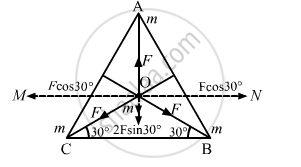Advertisements
Advertisements
प्रश्न
Three equal masses m are placed at the three corners of an equilateral triangle of side a. Find the force exerted by this system on another particle of mass m placed at (a) the mid-point of a side, (b) at the centre of the triangle.
उत्तर
(a) Consider that mass 'm' is placed at the midpoint O of side AB of equilateral triangle ABC.

AO = BO = \[\frac{a}{2}\]
Then \[\overrightarrow{F}_{OA} = \frac{4G m^2}{a^2}\] along OA
Also, \[\overrightarrow{F}_{OB} = \frac{4 G m^2}{a^2}\]along OB
OC = \[\frac{\sqrt{3}a}{2}\]
\[\overrightarrow{F}_{OC} = \frac{4 G m^2}{\left\{ \left( 3 \right) a^2 \right\}} = \frac{4G m^2}{3 a^2}\] along OC
The net force on the particle at O is \[\overrightarrow{F} = \overrightarrow{F}_{OA} + \overrightarrow{F}_{OB} + \overrightarrow{F}_{OC}\]
Since equal and opposite forces cancel each other, we have :
\[\overrightarrow{F} = \overrightarrow{F}_{OC} = \frac{4 G m^2}{\left\{ \left( 3 \right) a^2 \right\}} = \frac{4G m^2}{3 a^2}\] along OC.
(b) If the particle placed at O (centroid)

All the forces are equal in magnitude but their directions are different as shown in the figure.
Equal and opposite forces along OM and ON cancel each other.
i.e., \[F\cos30^\circ= F\cos30^\circ\]
∴ Resultant force \[= F - 2F\sin30 = 0\]
APPEARS IN
संबंधित प्रश्न
Choose the correct alternative:
Acceleration due to gravity increases/decreases with increasing altitude.
Choose the correct alternative:
Acceleration due to gravity is independent of mass of the earth/mass of the body.
A rocket is fired from the earth towards the sun. At what distance from the earth’s centre is the gravitational force on the rocket zero? Mass of the sun = 2 ×1030 kg, mass of the earth = 6 × 1024 kg. Neglect the effect of other planets etc. (orbital radius = 1.5 × 1011 m).
State the universal law of gravitation. Name the scientist who gave this law.
State and explain Kepler's laws of planetary motion. Draw diagrams to illustrate these laws.
Can you think of two particles which do not exert gravitational force on each other?
A body is suspended from a spring balance kept in a satellite. The reading of the balance is W1 when the satellite goes in an orbit of radius R and is W2 when it goes in an orbit of radius 2 −R.
A particle of mass 100 g is kept on the surface of a uniform sphere of mass 10 kg and radius 10 cm. Find the work to be done against the gravitational force between them to take the particle away from the sphere.
The mass of moon is about 0.012 times that of earth and its diameter is about 0.25 times that of earth. The value of G on the moon will be:
How will the force of gravitation between two objects change if the distance between them is:
Infinite
What does a force do in the following case?
You twist a piece of rubber.
What does a force do in the following case?
You apply brakes to a running car.
You can change the direction in which an object is moving by___________.
Give the applications of universal law gravitation.
Particles of masses 2M, m and M are respectively at points A, B and C with AB = ½ (BC). m is much-much smaller than M and at time t = 0, they are all at rest (Figure). At subsequent times before any collision takes place ______.

Molecules in air in the atmosphere are attracted by gravitational force of the earth. Explain why all of them do not fall into the earth just like an apple falling from a tree.
How is the gravitational force between two point masses affected when they are dipped in water keeping the separation between them the same?
The gravitational force between a hollow spherical shell (of radius R and uniform density) and a point mass is F. Show the nature of F vs r graph where r is the distance of the point from the centre of the hollow spherical shell of uniform density.
